One of the top cities to visit in Vietnam, Hoi An is most known for its charming Ancient Town. The 400-year-old former trading post feels much like an outdoor museum, made all the more captivating when set aglow by colorful lanterns at night.
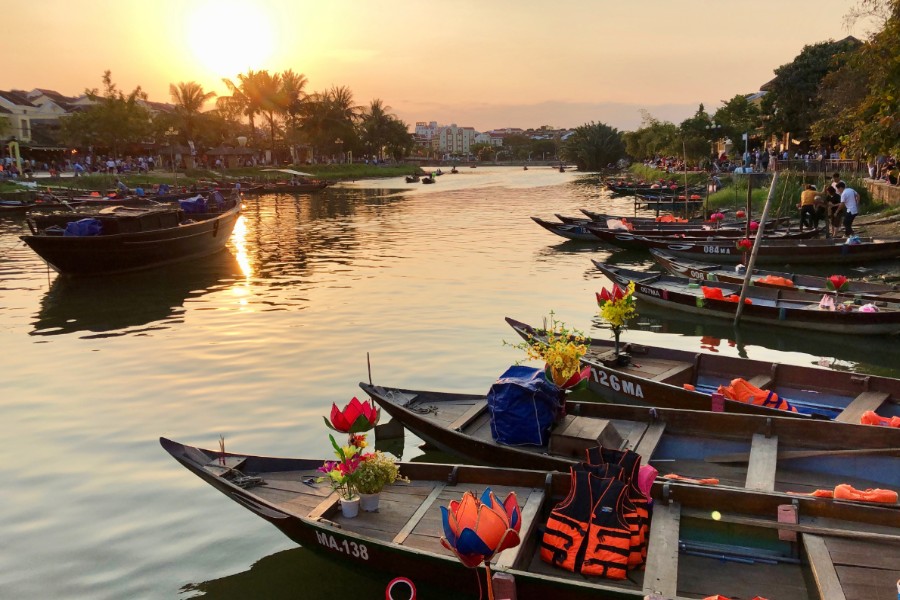
The Thu Bon River runs through Hoi An’s Ancient Town (Photo: Bre Power Eaton for TravelMag.com)
With its white sandy beaches, Hoi An provides a relaxing break from the seemingly nonstop action in Vietnam’s largest cities. The main draw, though, is Hoi An’s charming Ancient Town. From the 15th to 19th century, the area was a bustling trade hub, thanks to the Thu Bon River’s connection the East China Sea. Today, the river remains central to local livelihoods, particularly for fisherman, and continues to lure visitors with an almost magnetic pull to dine along its banks or take a scenic boat ride.
At first, the old town may feel like a local-gem-turned-tourist-attraction. In a sense, it is. The very walkable streets of this World Heritage Site are lined with shops, tailors and leatherworkers, all selling seemingly identical products. Still, the well-preserved, mismatch of architecture, marked by centuries of cultural confluence, lends an alluring sense of travel across time and space.
Ancient Chinese, Japanese and French constructions intermingle with tiled-roof, traditional Vietnamese buildings, many of which are open to the public as museums or revamped as galleries, eateries and shops. The old quarter is made all the more magical by the abundance of brightly colored lanterns, strung from streetlights and trees, like tantalizing gum drops.
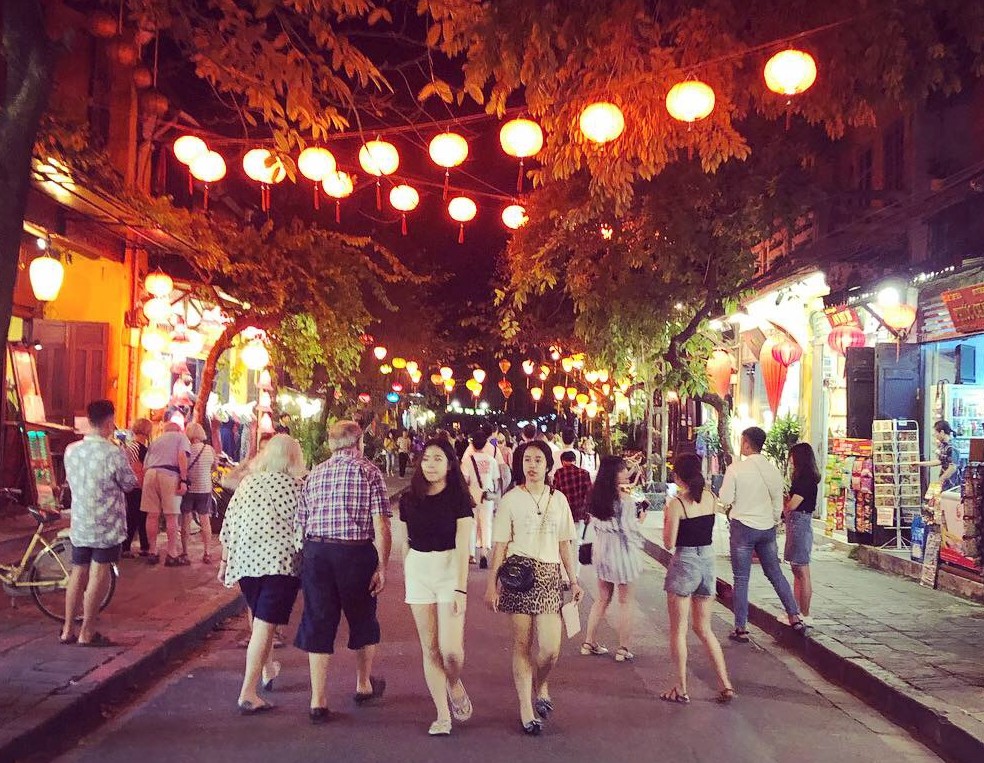
Hoi An glows at night (Photo: Bre Power Eaton for TravelMag.com)
Note: Support preservation efforts by purchasing a ticket to enter the city at one of the many kiosks on the outskirts of town. While loosely monitored, the tickets are inexpensive and include entry to five of the various heritage sites around town, from ancient homes to temples and museums. Though the tickets say 24 hours, it is generally accepted to use the ticket for your entire stay.
Things To Do
Much of your time in Hoi An can easily be spent strolling the Ancient Town’s narrow pedestrian pathways. The best way to find these areas is to head toward the streets of Tran Phu, Nguyen Thai Hoc, Bach Dang and Nguyen Phuc Chu. Leisurely wandering these passageways can be an event in itself, especially if you visit the many shops, galleries and cafés tempting you from every side. Note: When looking for specific addresses, be aware that many buildings along the Thu Bon have two entries, since ancient shop owners used to serve customers coming in from the street on one side and accept goods delivered from the river.
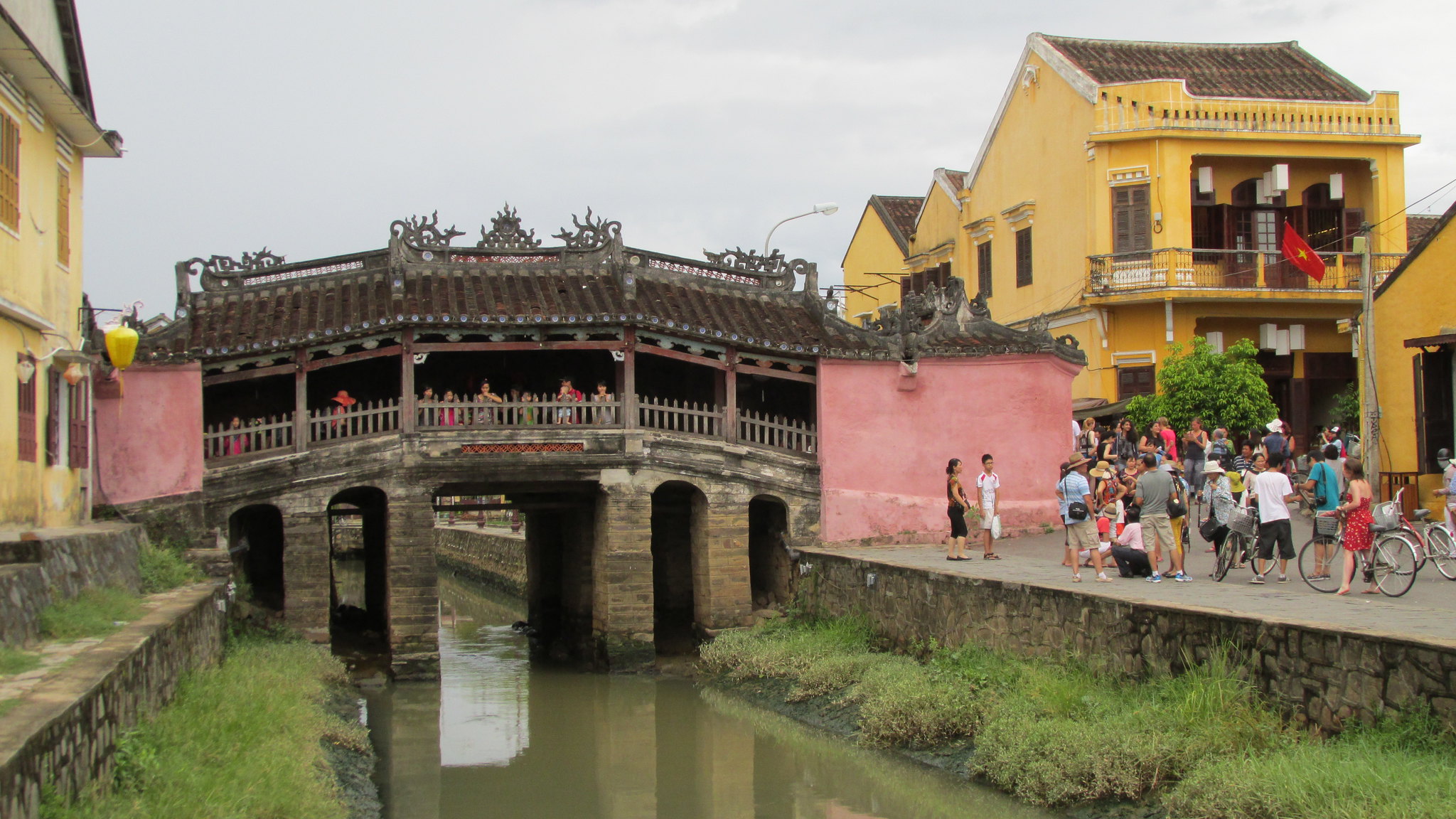
The iconic Chua Cau Japanese Bridge (Photo: garycycles8 via Flickr / CC BY 2.0)
The historic quarter is also home to cultural landmarks, like the iconic Japanese covered bridge, also known as Chua Cau (pagoda bridge), which dates back to the 17th century, when it served as the means for Japanese locals to cross the river and reach the Chinese quarter. Located on the west end of the old town, the bridge connects Nguyen Thi Minh Khai Street to Tran Phu Street. Ornately carved and painted, the tiled-roof bridge is often packed with people, with phones and cameras in hand, squeezing in for selfies or patiently waiting to nab a clear shot of this treasured symbol of Hoi An.
Another popular heritage site is Hoi Quan Quang Dong (176 Tran Phu Street), the Cantonese Assembly Hall. Parts of the elaborately decorated building were first assembled in China and then shipped to Hoi An. Just beyond the bright red and turquoise gates awaits a small garden. Statues of various sizes decorate the grounds, but the two dragons stand out, particularly the dragon mosaic sculpture, with its kaleidoscope of colors. The hall becomes especially lively during the Nguyen Tieu Festival, lantern festival, held on the 15th of the first month of the Lunar Year. During the sixth month, on the 24th, another festival honors the revered Chinese general Quan Cong, whose statue sits in the main hall. The ornate 17th century Quan Cong Temple and Pagoda (24 Tran Phu) also honor this ancient dignitary.
If you want to be in the heart of the action, eat and shop your way through a market. The smaller Central Market (on Tran Quy Ca and Bach Dang) will give you a taste of the shopping overload you’ll find later in the evening at the larger Hoi An Night Market, located outside the old quarter, just across the bridge, on An Hoi Islet, along Nguyen Hoang Street. Here, the air is electric. Work your way through the throngs of people as you navigate what to just eye and what to buy from more than 50 booths. Expect souvenirs, clothing, jewelry and a bounty of snacks and sweets, ranging from meat skewers to Vietnamese pancakes to ice cream rolls and sweet glutinous rice wrapped in banana leaves. The most visually appealing booths, though, sell Hoi An’s characteristically colorful lanterns, in all shapes and sizes.
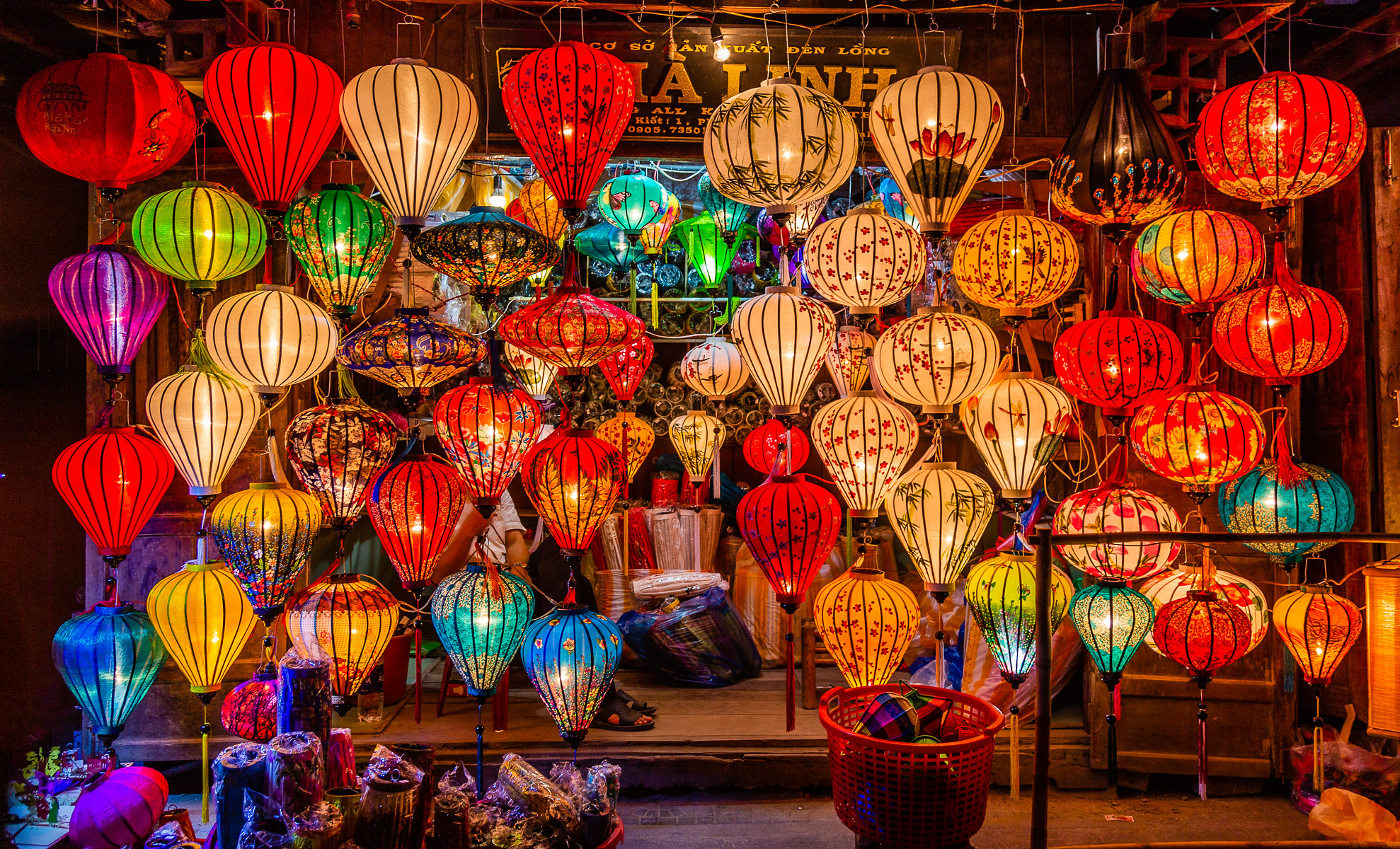
Lanterns at the Night Market (Photo: Phil Norton via Flickr / CC BY-NC-ND 2.0)
If you are lucky, your visit will land on the lunar calendars 14th night, when the Ancient Town celebrates the Full Moon Lantern Festival. On this festive night, the town goes dark, save for the light given off by colorful lanterns hung overhead and on boats floating along the river. Tip: If you want to visit during this sought-after celebration, book your accommodations early.
Those interested in local artistry might consider spending a few hours wandering the Thanh Ha Pottery Village (Phạm Phan), where you can watch artists spin and mold pots, jars, animal-shaped figurines and more, as they have been doing here for over 400 years. Just a mile outside the old town, the small riverside village is easy to access on your own (on foot, by bike, or taxi) or with a tour. Feel free to enter the workshops and watch the artisans at work. Some may even invite you to give their wheels a spin.
Where to Stay: Hotels & Resorts
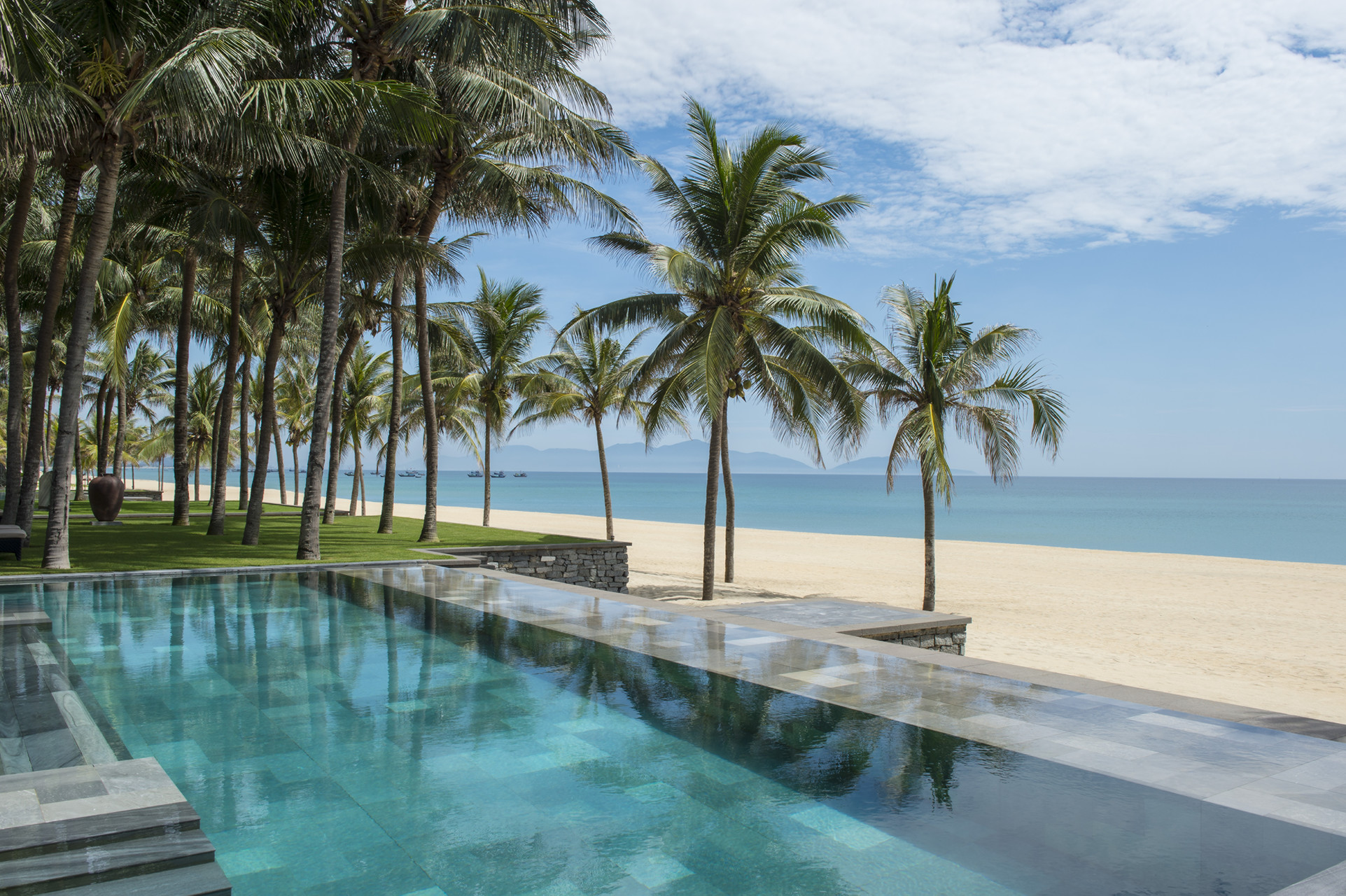
Private pool outside a beachfront villa at the Four Seasons Resort The Nam Hai (Photo: Guntil Reto, courtesy of Four Seasons Resort The Nam Hai)
Looking to get away from it all and spoil yourself while you’re at it? The beachfront Four Seasons Resort The Nam Hai (Block Ha My Dong B, Quang Nam) pairs luxurious villas, built in the traditional timber style, with a holistic spa experience dedicated to rejuvenation of the mind, body and soul. The Heart of The Earth Spa and Thanh Tĩnh Yoga Pavilion offer services, classes and retreats, geared to reconnect you with the earth to regain a sense of balance and harmony. Feel ever-lighter as you float in one of the three beachfront pools, surrounded by lush palm tree garden. Sink your toes into the private beach’s white sands, while the kids play in the sandbox and pool at the supervised Chuon Chuon Kids Club. On-site restaurants, cooking and craft classes, water sport rentals, tennis courts, and much more, make it easy to stay put, until you’re ready to take the shuttle into town.
Set amidst the bustle of the Ancient Town—we’re talking a rooftop infinity pool overlooking the Thu Bon River—Little Riverside (09 Phan Boi Chau) offers a mix of traditional architecture with modern amenities. The boutique hotel’s convenient location makes it easy to visit attractions nearby and pop back in to enjoy the pool and spa or dine at the riverside restaurant before heading out to explore again, on foot or on a hotel-provided bike. To dip your toes in the sea, hop on the shuttle for a quick ride to the hotel’s private beach.
If you’re interested in actually staying on the beach, but for less of a dent in your pocket book, consider Boutique Hoi An Resort (34 Lac Long Quan). Rooms and villas have balconies and terraces with ocean views, and some even have beach access. Either way, you’re always just steps away from Ang Bang Beach’s white sands and a five-minute shuttle ride to the Ancient Town. Relaxing poolside and getting a massage at the spa might tempt you to linger longer at the resort, where you can also take a Vietnamese cooking class or get your fill at the various eateries and bars on the premises.
Like a Local: Eat and Drink
While there are restaurants and food stalls throughout Hoi An, the most convenient way to get your fill is to dine and drink as you wander the old town. Like merchants who visited the port centuries ago, you may find yourself drawn to the Thu Bon River. A stroll along the river on Bach Dang Street, affords the added bonus of surveying the variety of food stalls, eateries, cafés and bars that offer a river view and people watching.
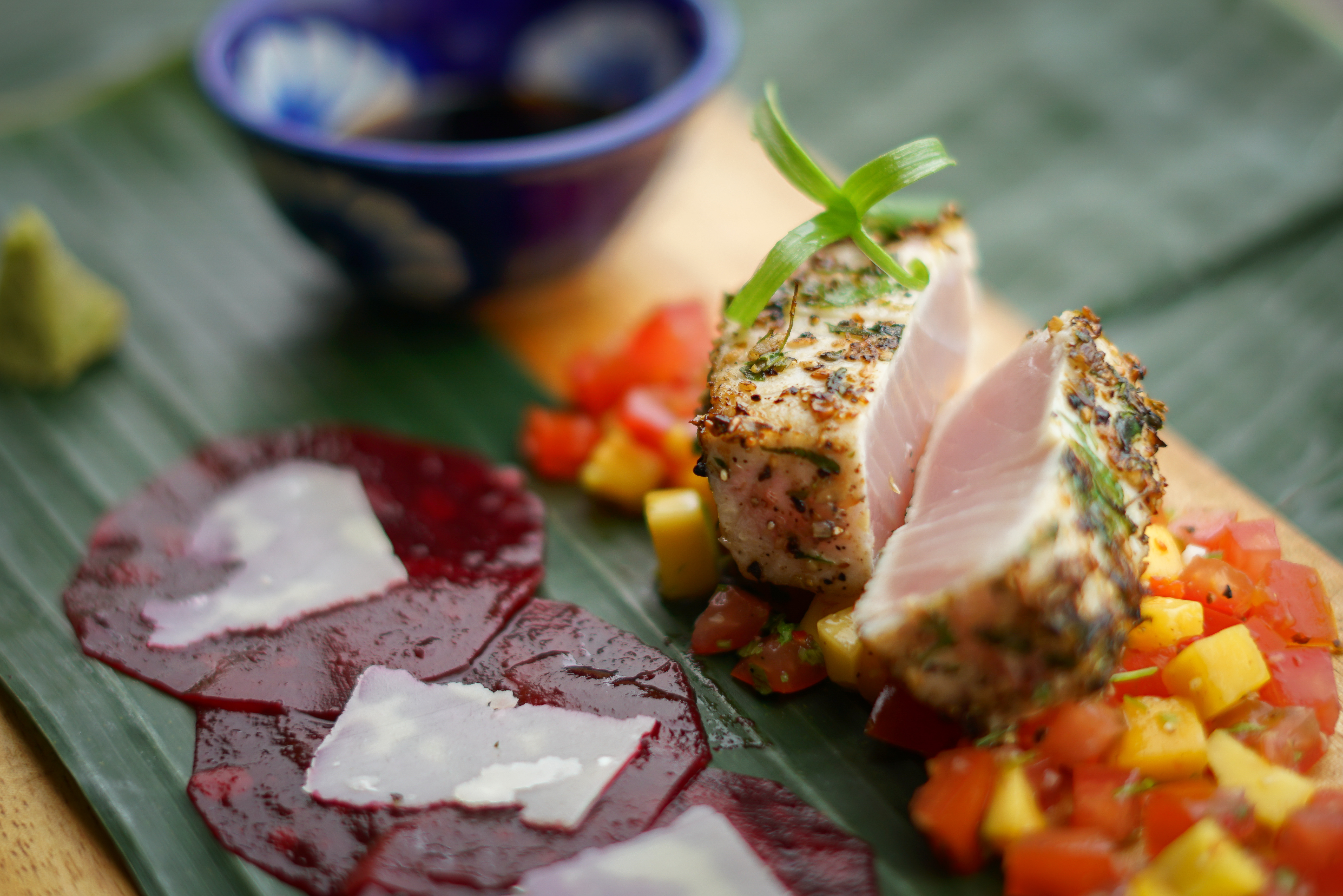
Dishes are delicious and beautiful at Mango Mango (Photo: Chris Love)
Riverside sister restaurants Mango Mango (45 Nguyen Phuc Chu), Mango Rooms (111 Pho Nguyen Thai Hoc) and Mai Fish (45 Nguyen Thi Minh Khai) are not to miss, particularly for anyone who enjoys thoughtfully prepared food, meant to entice the eyes as much as it excites the taste buds. Each restaurant’s creative cuisine and colorful ambiance reflect the owner Chef Duc’s upbringing in a Mexican household in Texas, after he left Vietnam by boat at just 15 years old. His adventurous spirit and sense of humor permeate the menu, with dishes like Mango Mango’s “Lust in Translation” (seaweed- and rice- paper-wrapped tuna rolls, drizzled with passion fruit-mint yogurt sauce), a nod to his past as a sushi chef.
Eating al fresco on the garden patio or balcony at Lantern Town Restaurant (49 Nguyen Thai Hoc) also provides lovely river views. Inside, myriad lanterns capture the city’s characteristic rainbow glow. The extensive menu is filled with vibrant takes on Vietnamese and Hoi An specialties, like a seafood version of the area’s famed cao lau noodles, which are traditionally topped with pork. Other satisfying picks include the Hoi An sample plate, pomelo salad, grilled fish wrapped in banana leaves and duck with cashew nuts. A section of Western food is also available for diners who prefer to stick with pizza or chicken nuggets.
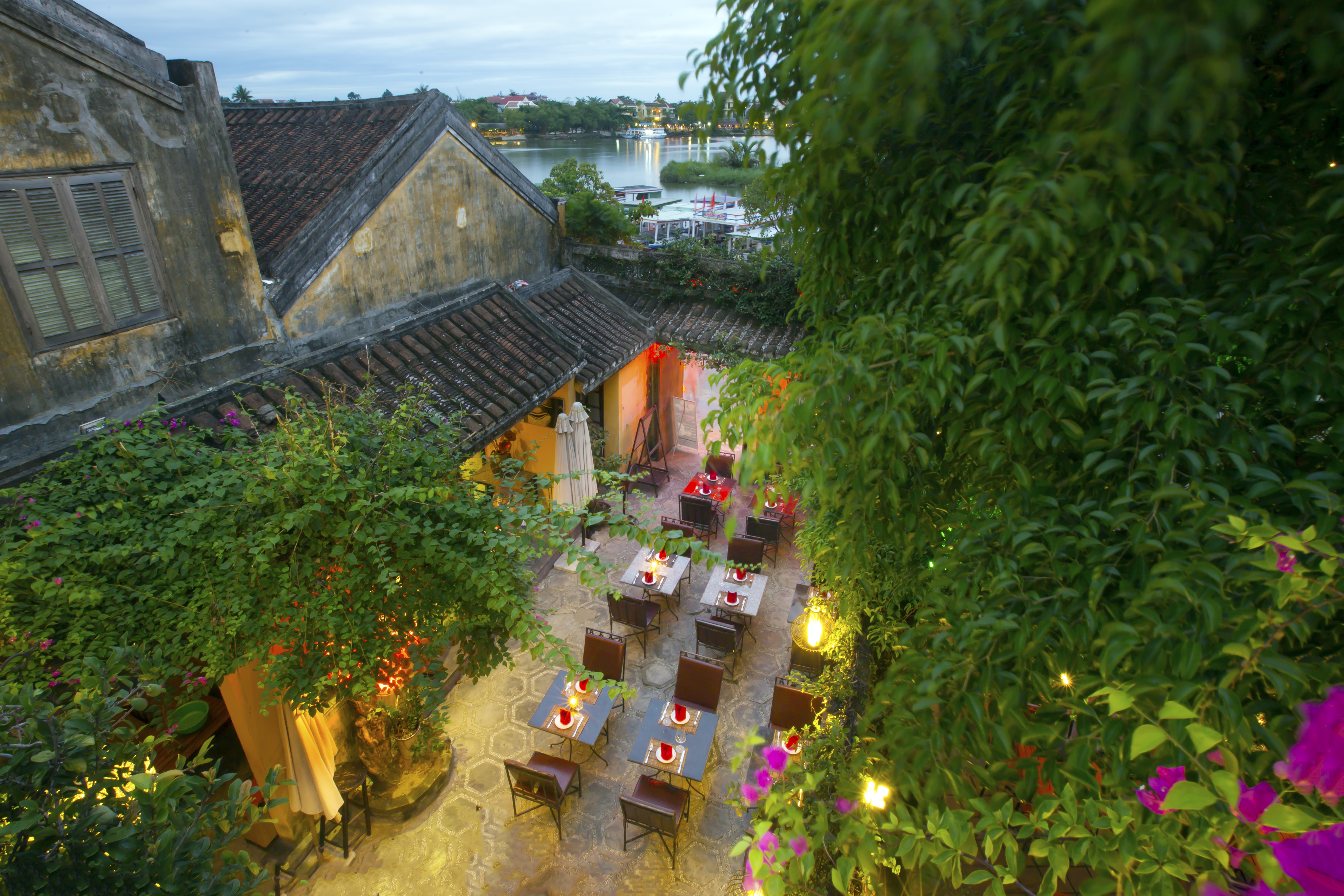
Festive riverside dining at Lantern Town (Photo: Courtesy of Lantern Town Restaurant)
Oenophile’s interested in pairing wine with traditional and fusion-inspired Vietnamese cuisine should check out Lantern Town’s chic sister restaurant The Hoianian Wine Bar & Restaurant (38 Phan Chu Trinh St.). Pho fans can get their fix at yet another sister restaurant, fittingly named the Noodle House (13 Bach Dang St.), where you can slurp your soup while admiring the river. The newest addition to the popular restaurant group is the riverside Hoi An Eatery and Lounge (73 Bach Dang St.).
Another favorite found deeper in town is The Chef Restaurant and Café (166 Tran Pha), known for its romantic, lantern-lit rooftop terrace and expansive cityscape view. Choose from a mix of traditional and non-traditional dishes, ranging from spring rolls and banh mi to sautés, noodles and curries. The banana blossom salad and mango chicken pair nicely with a fruity cocktail or fresh juice. The restaurant is located on the second and third floors, above an Artbook shop, a must-visit described in the shopping section below. Note: cash only, so come prepared.
If you are in search of Hoi An’s best banh mi, take Anthony Bourdain’s advice and order a sandwich “thap cam,” with everything on it, at Banh Mi Phuong (2b Phan Chu Trinh), a local gem that has only grown in popularity since the late foodie-adventurer raved about it. You’ll need both hands to eat the bulging baguette—perfectly crisp outside and soft inside–filled with a flavorful mix of pate, pork, cucumber, lettuce, herbs, fish sauce, and an optional fried egg. Wait in line and order near the entrance and take your sandwich inside, if you can find a seat, or take it to-go.
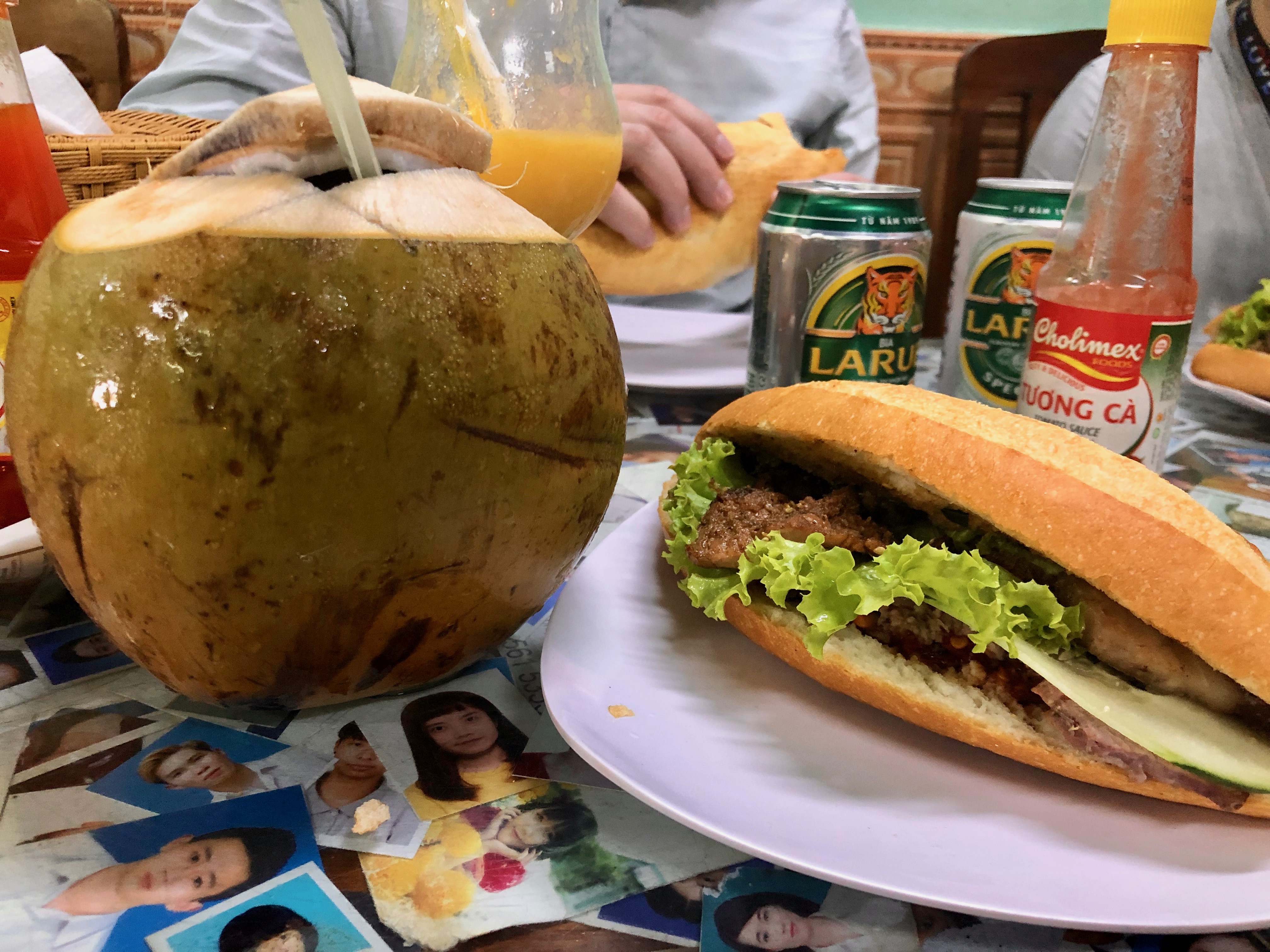
Banh Mi Phuong’s sandwiches, made famous by Anthony Bourdain (Photo: Bre Power Eaton for TravelMag.com)
For a cheap, quick taste of another Hoi An specialty, head to the White Rose Restaurant (533 Hai Ba Trung St.), the original home of the flower-shaped “white rose” dumpling. Located just outside Ancient Town, the restaurant serves only two dishes: the delicate dumplings (banh bao vac), filled with shrimp and topped with friend shallots, and fried wonton. The latter is reminiscent of nachos, with fried wonton sheets topped with a mixture of shrimp and vegetables. Try the white rose here or do a taste test around town to see if any other attempts rival the original.
If you’re looking for a kickback spot to enjoy a glass of wine or fresh beer along the river, head to Cyclo’s Road Café (97 Bach Dang). Sit on a low stool on the front patio or head upstairs to the balcony. The family-run joint is often packed with travelers returning night after night to get in another chat with the owner along with a cheap drink or meal. Word has it that Cyclo’s is also a great spot to try the ubiquitous white rose dumpling.
Café Culture and Sweets
Catching up over coffee is central to Vietnamese daily life, evident by the abundance of cafés and coffee shops. Many have balconies and patios, making it easy to pause, yet still feel a part of the scene.
For an interesting twist on tea, head to Cocobana (16 Nguyen Thai Hoc St), a café that pairs its selection of 20-plus delightful teas, served in ceramic cups, with the option for a hot or cold foot bath—a perfect way to prep or payback your paws for long days of exploring. The 200-year-old characterful house is made all the more inviting by a floral garden and koi pond, and all the more relaxing with cozy seating options. Once you convince yourself to finally rise from a hammock, linger even longer by visiting the paper making studio, gallery and craft-filled shop. Leave your mark by adding your name to a bamboo leaf on the visitor tree.
Another popular rest stop is Cocobox café, unique for its aim to use organic, locally-sourced ingredients. Sit on the patio and people watch, with a refreshing fresh-pressed juice, smoothie, tea or coffee. The small shop inside offers a variety of organic and fair-trade goods, from soaps and lotions to chocolate bars.
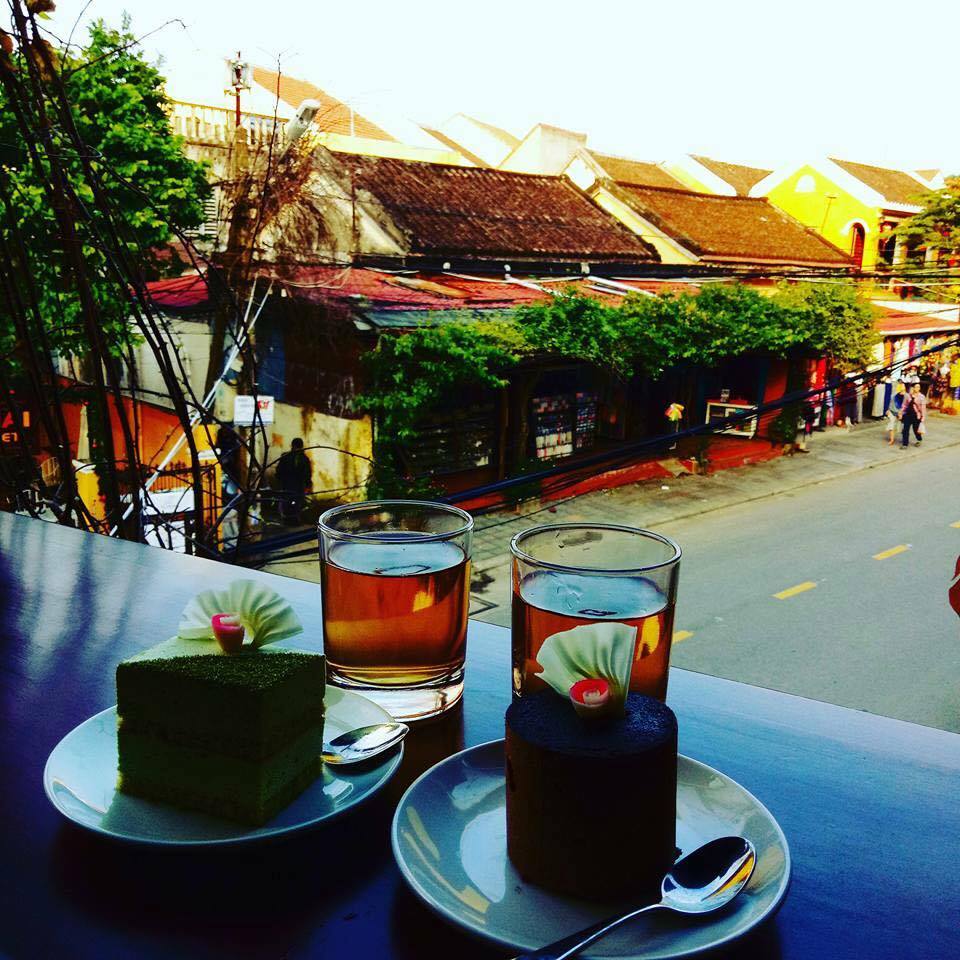
A sweet view at Mun Coffee (Photo: Courtesy of Mun Coffee)
Find a tranquil place to perch on the flowery balcony at Mun Coffee (79 Phan Chau Trinh), where you can enjoy your coffee, smoothie or juice while taking in the buzz below. Inside, the café’s contemporary décor, ample seating and air conditioning make it a cozy place to cool down. A selection of beautiful cakes and pastries make for a tempting tea time pick me up or late-night dessert.
To satisfy your sweet tooth like a local, keep an eye out for hawker stall names that begin with “che,” which means “dessert” in Vietnamese. Less sweet than a frosted sheet cake or brownie sundae, local desserts include ingredients often found in meals, like the sweetened red beans in che ma bau (with mung bean paste, and pandan jelly, topped off with coconut milk) and sweet corn-based Chee Bap (with glutinous rice or tapioca). Another treat specific to Hoi An is Bánh Xoai or mango cake. Don’t let the name deceive you: the white, glutinous rice cake is the size of a tiny mango but does not include or even taste like the actual fruit. Instead, stuffed inside the soft, chewy shell awaits a sweet mix of sesame seeds and peanuts.
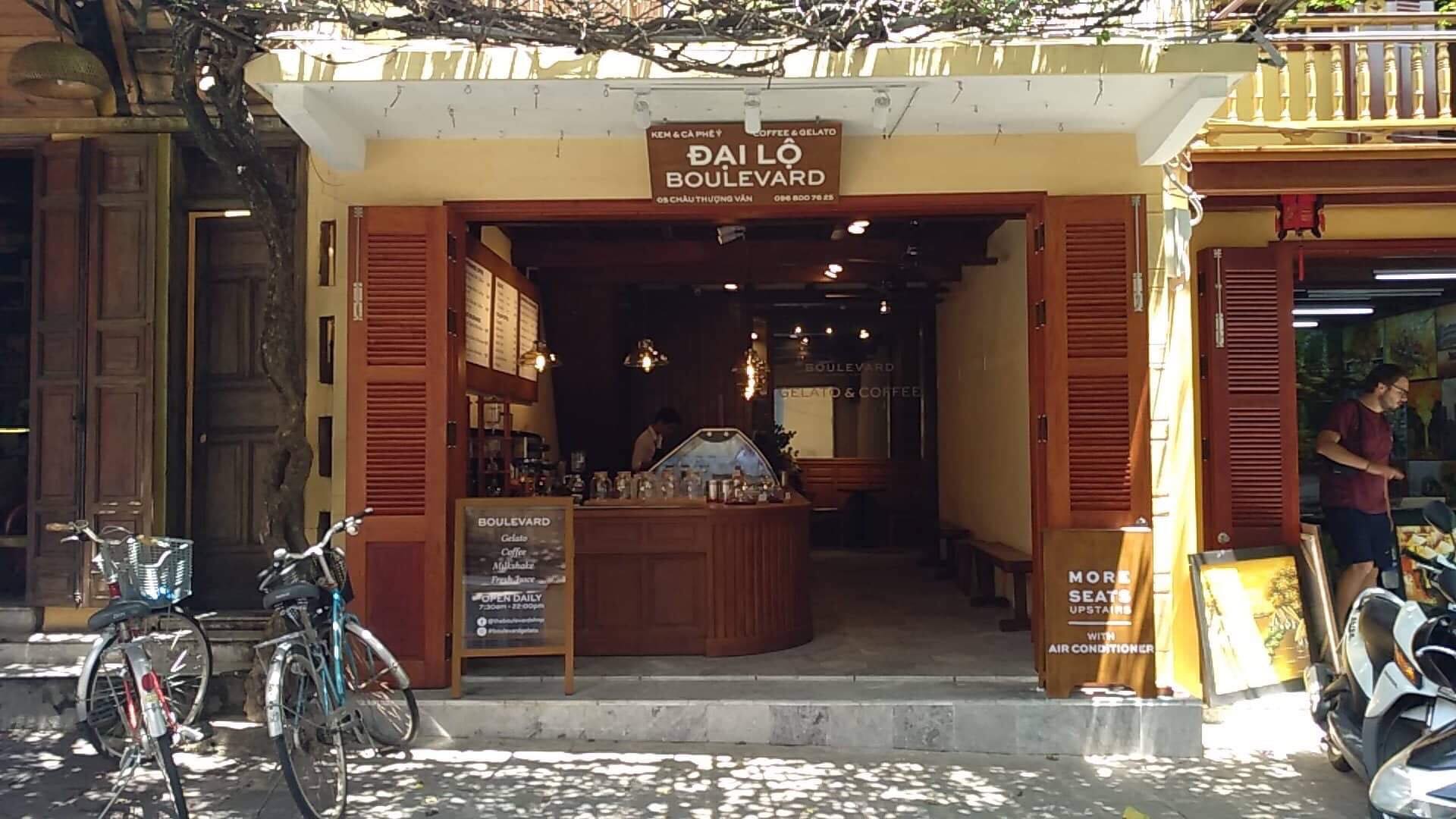
Gelato heaven, Boulevard (Photo: Courtesy of Boulevard)
If street sweets do not tame your cravings, Boulevard (05 Chau Thu’o’ng Van) has you covered. Made in-house, the creamy gelato is displayed in temptingly colorful mounds. Favorites range from Nutella, salted caramel and Vietnamese coffee to fruity flavors, like passion fruit, coconut and kumquat. Seating is available upstairs, where you can enjoy a coffee and linger long after you finish your cone. Luckily, the popular spot has continued to grow, with two take-away branches (10 Nguyen Thi Minh Khai and 647 Hai Ba Trung) where you can get your fix on the go.
Shopping
On the main streets of the old town, you can hardly walk a few steps without a chance to open your wallet, from locals selling food, art, and toys to stylish boutiques and tourist-centric shops.
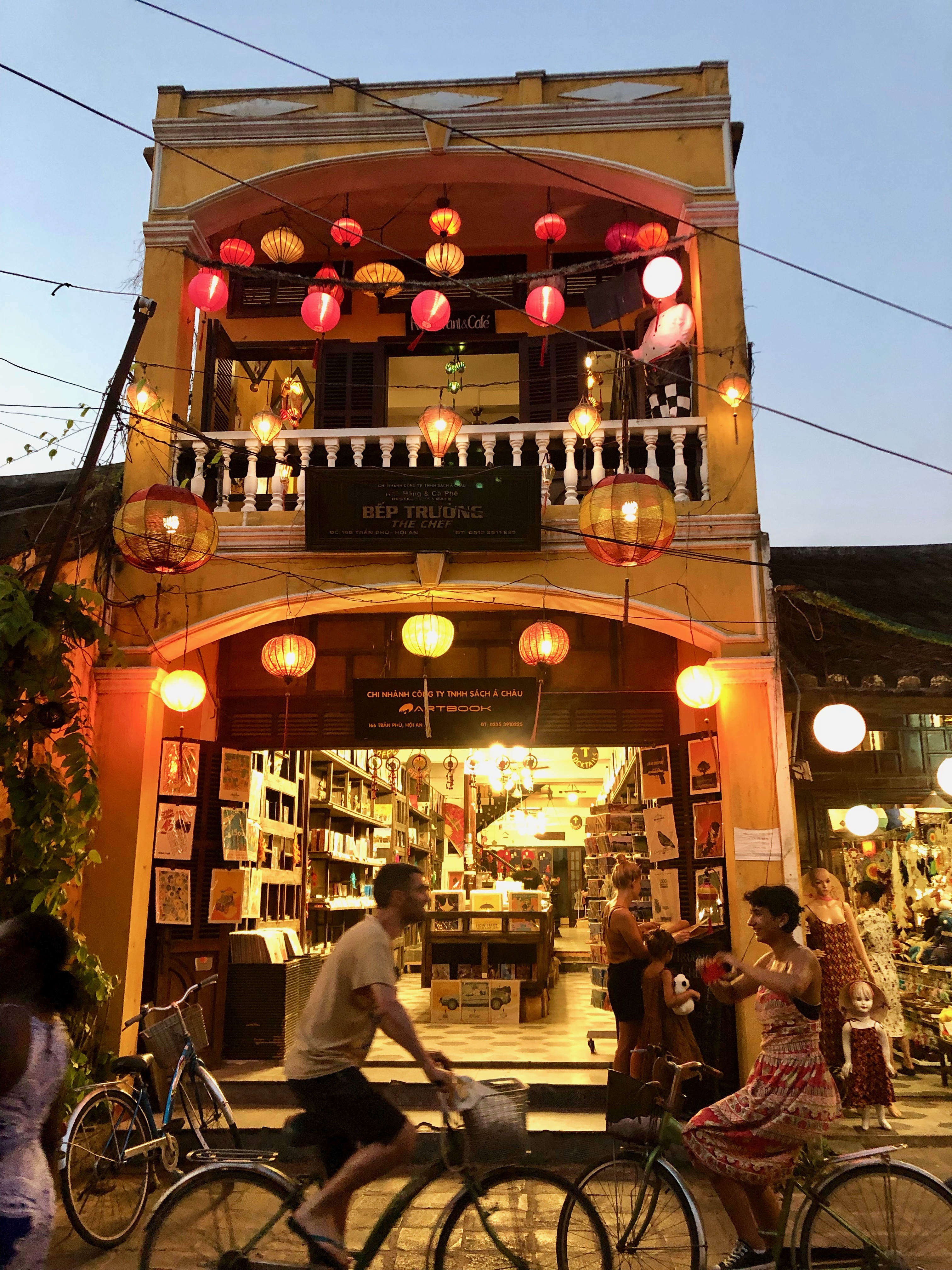
Artbook, first floor, and The Chef, second and third floors (Photo: Bre Power Eaton for TravelMag.com)
When you spot an Artbook (166 Tran Phu), it may feel like déjà vu, since the popular chain has many shops throughout the country. To thoroughly enjoy your shopping experience here, make time to slowly explore the curious finds on every shelf. Beyond books and the expected post cards and snow globes, you’ll find colorful crafts and local wares–unique souvenirs that gift-receivers will actually want use and display back home. Pair shopping with a drink or meal at The Chef, which is located on the second and third floor, above the shop.
If you’re searching for stylish clothing, unlike the repetitive colorful pants and dresses packed onto many storefront racks, step into Mui the Label (15B Le Loi St.). The storefront alone, with its arrangement of unique, handmade bags, hints at something different. What awaits inside are styles designed by the owner and sewn by her mother, a dynamic duo! The line’s style leans toward bohemian, with stylish appeal that is comfortable to the touch. Accessories and handbags make it easy to assemble an entire outfit or stock up on gifts for the stylephiles in your life.
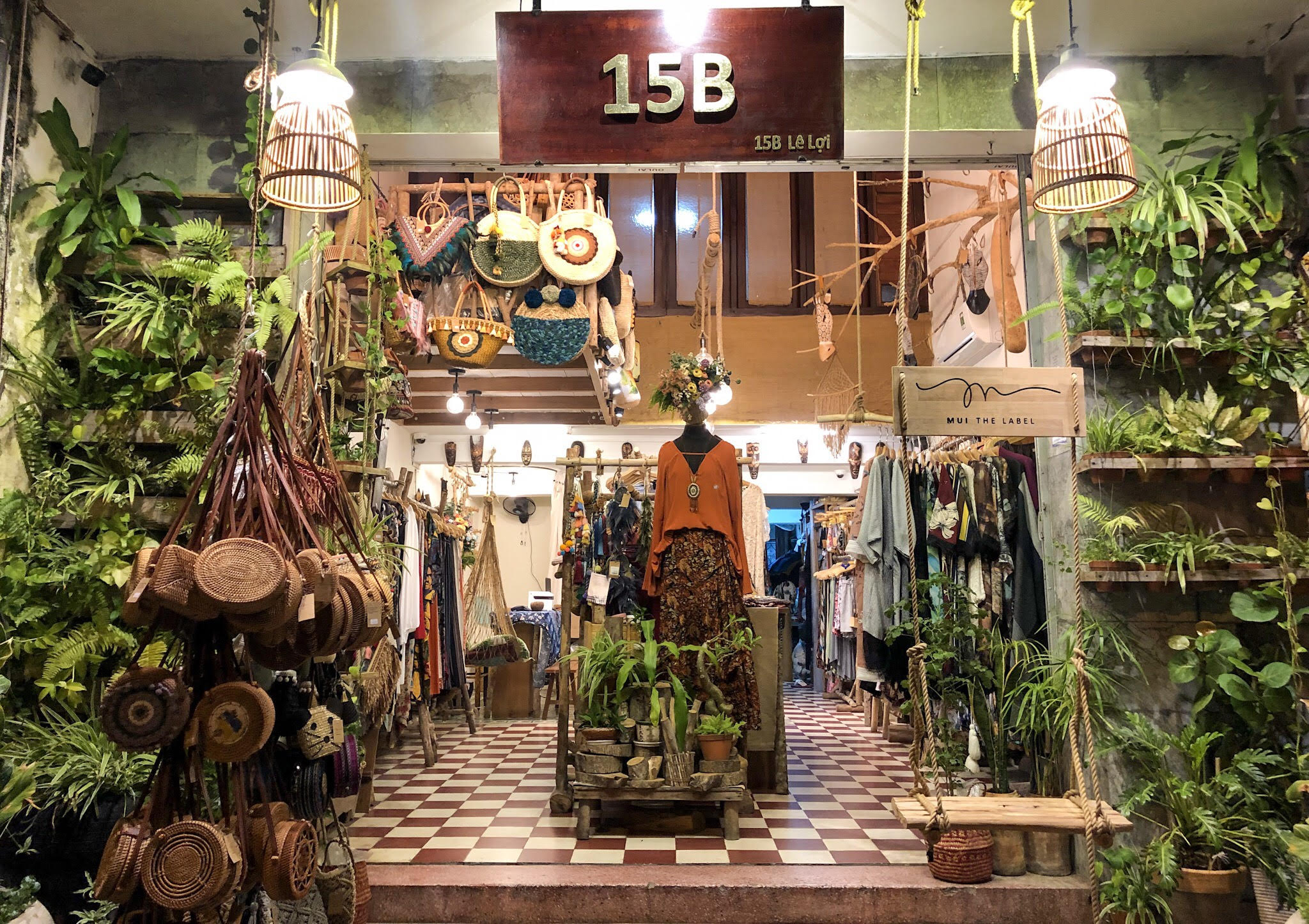
Mui the Label’s styles are created by a dynamic mother-daughter duo (Photo: Courtesy of Mui the Label)
If your non-traveling life requires wearing suits daily, or you’ve ever dreamed of having an outfit that fits every angle and curve, take advantage of the town’s tailors, all vying to personalize your wardrobe. The process may take two days or more, depending on what you want to have made and how much. While walk-ins are usually available, if you can, make an appointment ahead of time or soon after you arrive, as you’ll need to return a few times to be fitted. Kimmy Custom Tailor (70 Tran Hung Dạo) has received rave reviews for couture quality and fast, friendly service. Bring in a photo or choose your preferred styles from the shop’s iPad-based portfolio. Then, run your fingers along the walls and booklets of fabrics, all with the guidance of a stylist, dedicated to ensuring you leave with a perfectly-fitted keepsake from Vietnam.